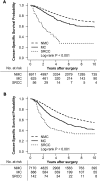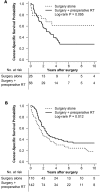Prognosis and value of preoperative radiotherapy in locally advanced rectal signet-ring cell carcinoma
- PMID: 28345614
- PMCID: PMC5366911
- DOI: 10.1038/srep45334
Prognosis and value of preoperative radiotherapy in locally advanced rectal signet-ring cell carcinoma
Abstract
As well known, signet-ring cell carcinoma (SRCC) is a rare histological subtype of colorectal adenocarcinoma, which has been associated with poor prognosis and resistant to non-surgery therapy compared with common adenocarcinoma. In this study, we assessed the effect of preoperative radiotherapy (PRT) for locally advanced rectal SRCC in a large patient group from the Surveillance, Epidemiology, and End Results program (SEER, 1988-2011) database. SRCC was found in 0.9% (n = 622) rectal cancer (RC) patients in our study. In the PRT setting, SRCC had significantly worse cancer-specific survival than mucinous adenocarcinoma and nonmucinous adenocarcinoma patients (log-rank, P < 0.001). In terms of SRCC, stage III RC patients benefited from PRT (log-rank, P < 0.001) while stage II did not (P = 0.095). The multivariate Cox proportional hazard model showed that PRT was an independent benefit factor in stage III rectal SRCC patients (HR, 0.611; 95% CI, 0.407-0.919; P = 0.018). In conclusion, SRCC was an independent predictor of poor prognosis in stage III RC patients, but not in stage II. In the PRT setting of locally advanced RC, SRCC patients had significantly worse prognosis. PRT was an independent prognostic factor associated with improved survival in stage III rectal SRCC.
Conflict of interest statement
The authors declare no competing financial interests.
Figures


References
-
- Hamilton S. R. & Aaltonen L. A. World Health Organization Classification of Tumours: Pathology and Genetics of Tumours of the Digestive System. International Agency for Research on Cancer: Lyon, 2000 (2000).
Publication types
MeSH terms
LinkOut - more resources
Full Text Sources
Other Literature Sources
Research Materials

